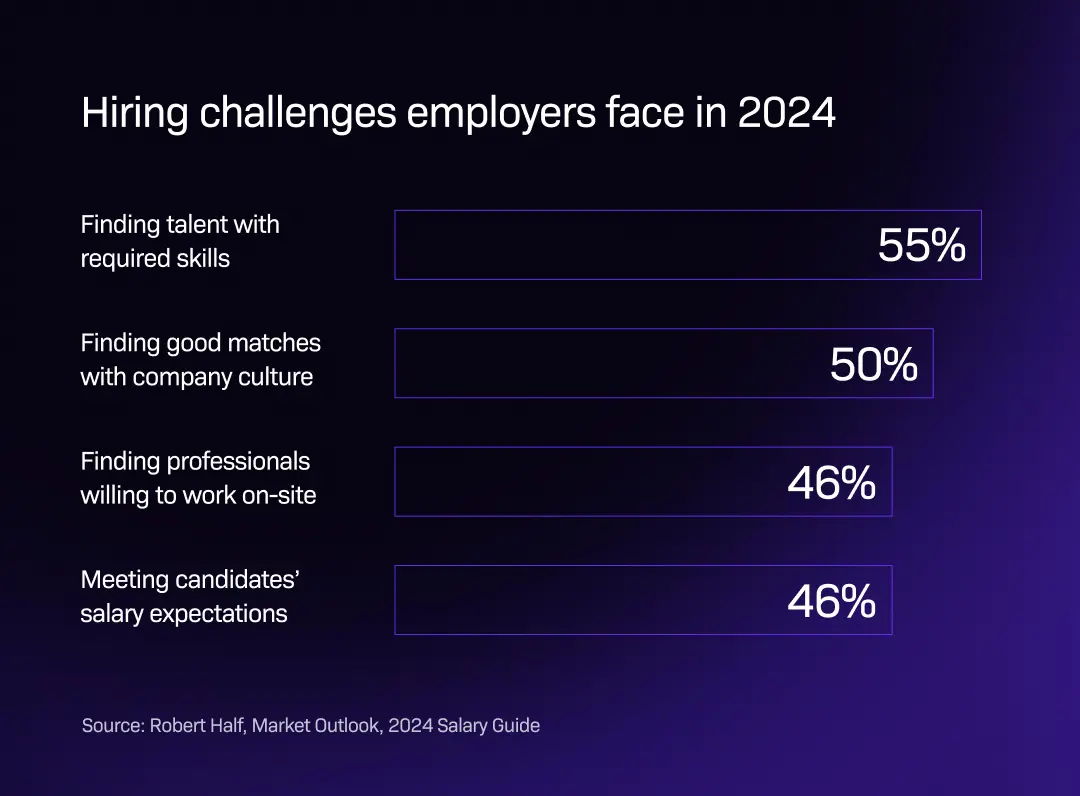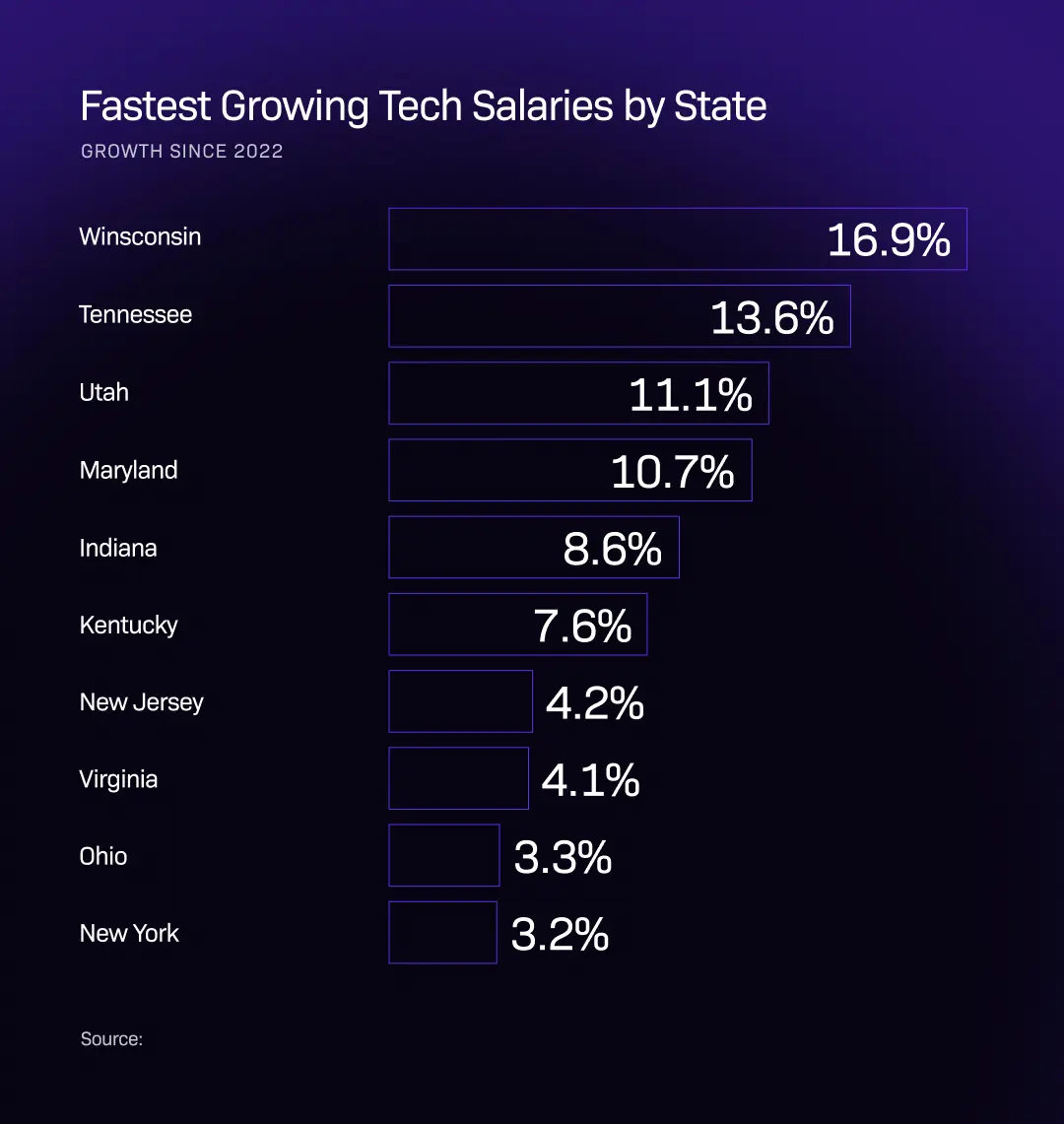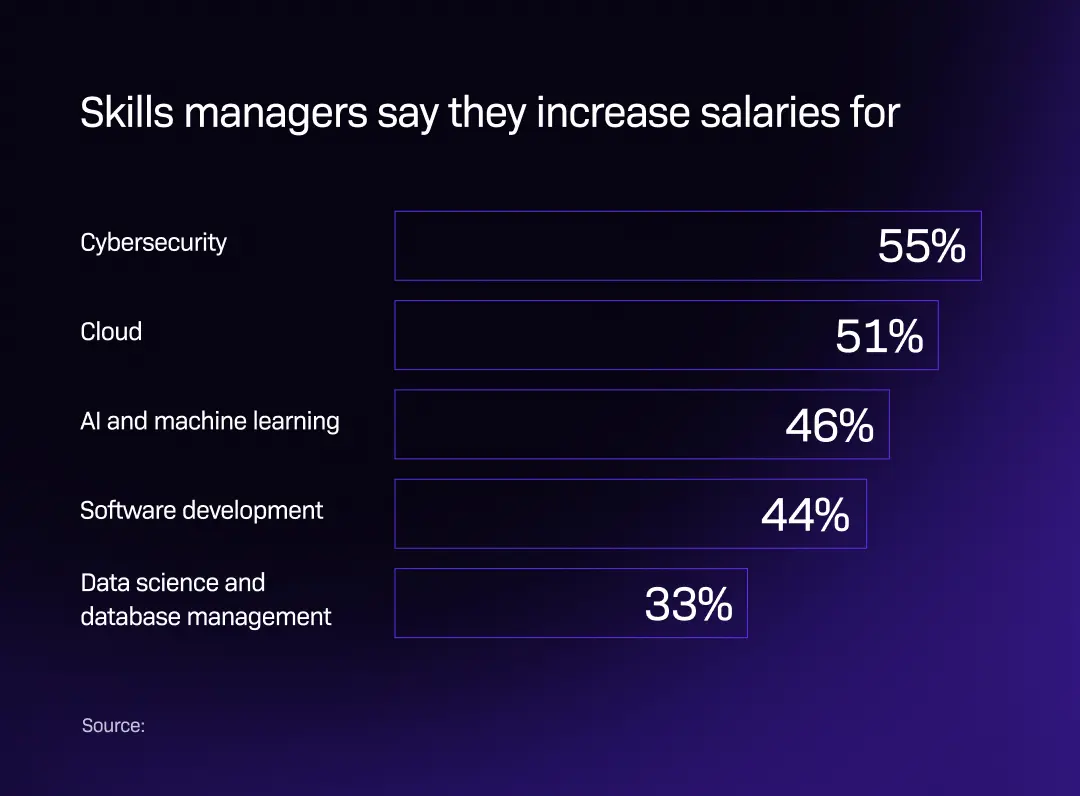
Scaling your business is thrilling yet challenging.
One crucial factor for success is having the right team.
Staff augmentation offers a way to access needed skills without the full-time employee overhead.
This article explores three main staff augmentation options, examining their pros and cons to help you make a well-informed choice.
Drawing from personal experiences and client success stories, we’ll guide you through the best strategies to bolster your team and achieve your scaling goals.
1. Team Extension for a Single Team and Specialty
Ever wonder how some businesses seem to effortlessly scale and adapt to new challenges?
The secret often lies in team extension.
Imagine instantly accessing top-tier talent without the overhead costs of full-time employees. Sounds appealing, right?
In today's fast-paced business world, flexibility is key.
Did you know that 75% of companies have adopted remote work, with 83% of employers reporting increased productivity? And that's just the beginning.
By the end of 2024, businesses using team extension could see a 30% reduction in operational costs and a 20% boost in efficiency.
That’s like hitting the business jackpot!
The Perks of Team Extension
Access to specialized skills
Despite the highly publicized layoffs of 2023, the tech talent shortage in the United States remains unchanged, with nearly 4 million tech jobs still up for grabs (IT Salary Trends CIOs Need to Know in 2024).
Almost all tech leaders (95%) say they're struggling to find skilled talent, and over half (51%) foresee a big hiring challenge due to a shortage of applicants with the necessary skill sets to drive key projects forward (Building Future-Forward Tech Teams by Robert Half).

Need an expert for a specific project? Team extension lets you quickly fill those skill gaps with the best professionals out there.
The world is your oyster! Hire the best talent from anywhere, breaking free from geographical limitations.
Find out which countries have the best specialists in different tech fields
Save Big on Costs
Ever wonder why it's so tough for scaleups to keep up with salary increases? Let's dive in.
In 2024, US scaleups are in a bind when it comes to raising salaries.
Picture this: the job market is tight, and everyone is vying for the same top talent, especially in tech. This competition drives up salaries, making it harder for smaller companies to offer attractive pay packages without stretching their budgets thin.

Inflation isn't helping either. Even though it's cooling down, the cost of living remains high.
Companies need to increase salaries just to keep up, ensuring their employees can maintain their standard of living.

It's like running on a treadmill that keeps speeding up.
With team extension, you can say goodbye to hefty salaries. Remote talent can slash your costs by 20-30% per employee.
Here are the costs you could avoid:
- Benefits: 29.7% of compensation costs.
- Health insurance: $8,435-$23,968/year.
- Training: $1,286/year.
- Employee replacement: 6-9 months' salary.
Scale on Demand
Economic ups and downs make things even trickier for scaleups.
Picture this: you're trying to plan for the future, but the economic forecast is as clear as mud. Inflation is biting, and the job market is tighter than ever.
Scaleups have to walk a tightrope, offering attractive salaries to keep top talent while also keeping an eye on the bottom line. It’s a balancing act that’s as crucial as it is challenging.
Companies need to be savvy, managing costs smartly while ensuring their star players are happy and engaged. It’s all about striking the right balance to sustain growth and stability.
Imagine being able to adjust your team size on a whim—scaling up for big projects or down during quieter times. That's the beauty of staff augmentation. It offers scaleups the flexibility to bring in specialized skills without the long-term commitment of full-time hires.
This approach not only keeps costs in check by avoiding hefty benefits packages but also ensures you have the right expertise when you need it.
Plus, with control over your projects, you can maintain quality and meet tight deadlines, keeping your competitive edge sharp.
Challenges of Team Extension
But it's not all smooth sailing.
Let's dive into the challenges of the team extension model.
Time zone and language differences
Handling teams across different time zones and languages can be a challenge.
Imagine trying to coordinate a meeting when everyone’s on different clocks – it takes careful planning to avoid delays and ensure everyone’s available.
Communication can slip through the cracks, making it crucial to have clear protocols in place to prevent misunderstandings and keep everyone aligned.
Management effort
Managing remote teams also requires a bit more effort.
It means regular check-ins, clear task assignments, and consistent follow-ups to keep productivity on track.
Cultural integration
Cultural integration is another hurdle but an important one.
Bringing remote workers into your company culture takes effort but is key to building a cohesive team.
Including remote employees in team activities and fostering a sense of belonging can make a huge difference.
Discover our practical tips for collaborating with extended teams to unlock maximum benefits, complete with real-life examples from our successful client projects.
2. Managed Project with Team Owning a Specific Area
Ever felt overwhelmed by the demands of managing multiple projects?
The managed project model, where an entire team takes ownership of specific areas, might be your answer.
Imagine having a dedicated team that not only manages but also delivers complete projects, freeing up your internal team to focus on core activities.
This approach brings specialized expertise and clear accountability to your projects.
The Perks of the Managed Project Model
Complete project management
With a managed team handling entire projects, the need for constant oversight diminishes.
You can trust them to manage, execute, and deliver, allowing your in-house team to concentrate on strategic tasks.
Explore our case study with ChatFlow to see a successful example of this approach in action.
Access to specialized teams
These teams bring domain expertise, ensuring your projects benefit from the latest knowledge and skills.
For example, 15Five, a US-based SaaS company that enhances employee performance with feedback and tracking tools, outsourced Python development.
This allowed 15Five's co-founder to scale operations and focus on the product.
This approach is particularly beneficial for complex or technical projects, as it leverages specialized skills and keeps your core team focused on their strengths.
Clear ownership and accountability
Each team owns specific areas, making it clear who is responsible for what.
This clarity enhances accountability and often leads to better project outcomes.
Focus on core activities
By offloading specific projects to managed teams, your internal team can focus on what they do best.
This leads to increased efficiency and productivity across your organization.
Take DocuSign, for example.
They use staff augmentation for product development, cutting costs by half and maintaining team flexibility. The outsourced team works alongside DocuSign’s internal team, adding new features and providing support and maintenance.
Expensify, founded in 2008, organizes and stores expenses. They outsourced back-end development to speed up their release, allowing their team to focus on the front-end and business operations.
This strategy supports their growth to over 130 employees and 2 million users.
The Challenges of the Managed Project Model
Now you know the perks of the managed project model.
But what about the other side? What should you keep in mind when choosing this staff augmentation option?
Less control
Handing over project management means you have less direct control over how the project is executed. It requires trust and clear communication to ensure alignment with your goals.
Establish clear communication channels and set detailed project guidelines to keep things on track.
Increased reliance on external teams
Relying on external teams for critical projects can be risky.
If the external team fails to deliver, it can have significant repercussions on your business.
Choose reputable partners, set performance metrics, and have contingency plans to mitigate risks.
Ensuring alignment
Keeping external teams aligned with your company's goals and standards can be challenging.
It requires ongoing communication and sometimes additional management effort to ensure everyone is on the same page.
Ready to see how this model can work for you? Discover our practical tips for collaborating with managed teams, complete with real-life examples from our successful client projects.
3. Opening a remote office with buyout potential
Opening a remote office can be a game-changer for your business.
It establishes a permanent presence in a new location and gives you full control over operations, processes, and culture. Imagine tapping into a new talent pool and gaining local market insights.
This approach not only supports future growth but also opens up buyout opportunities down the line.
The Perks of Opening a Remote Office
Permanent presence
Setting up a remote office establishes a solid foothold in a new region. This permanent presence can help you build stronger relationships with local clients and partners.
Take Google’s investment in Wrocław, Poland, for example.
With cloud technologies booming, Google saw the perfect opportunity to expand.
They chose Wrocław to tap into Poland’s growing cloud market, which is expected to grow by 15-20% annually.
This move not only boosts local business but also sets the stage for the upcoming Google Cloud data center in Warsaw, enhancing cloud service accessibility and efficiency for Polish companies.
Full control
You maintain full control over operations, processes, and company culture. This ensures that your remote office aligns perfectly with your business goals and standards.
Access to talent and market insights
By tapping into a new talent pool, you can find skilled professionals who bring fresh perspectives. Additionally, gaining local market insights can help you tailor your strategies to better fit the regional context.
Google outsourced services such as cloud computing, software development, and cybersecurity to Poland, leveraging the region's technical expertise.
Local market insights help tailor strategies to fit the enterprises from all over Europe, enhancing the company's adaptability and competitiveness.
Growth and buyout opportunities
A remote office can be a stepping stone for future expansion. As your presence grows, so does the potential for mergers, acquisitions, or even a profitable buyout.
The Challenges of Opening a Remote Office
Significant initial investment
Setting up a remote office requires a substantial upfront investment. From leasing office space to purchasing equipment, the costs can add up quickly.
Navigating local regulations
Managing a remote office involves understanding and complying with local regulations, laws, and business practices. This can be complex and time-consuming.
Integration challenges
Integrating the remote office with your headquarters can be tricky. Ensuring seamless communication and alignment between the two locations requires careful planning and execution.
Learn how to make your remote office successful with our practical tips and real-life examples from client projects.
Conclusion
We've explored three powerful staff augmentation options: team extension, managed projects, and opening a remote office. Each model offers unique benefits, from accessing specialized skills to maintaining full control over operations.
These strategies can help you boost efficiency, reduce costs, and drive growth.
Ready to take your business to the next level? Apply these strategies to achieve your goals.
Remember, successful scaling starts with the right team.


